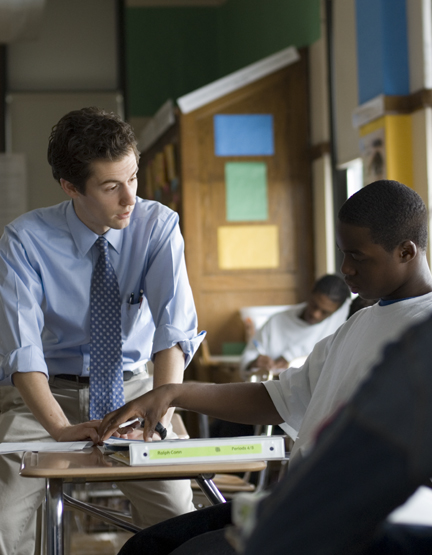Jeremy Robinson '04: Standing Against Despairby Howard W. Hewitt |
| Printer-friendly version | Email this article |
|
Robinson says he understands the racial tension.
"It’s a weird environment," he says. "Similar to what Alex Kotlowitz writes about in his book There Are No Children Here. Look around—these are not kids. Look at what they’re exposed to. What they have to deal with every day in the neighborhood is unfathomable for a person who lives outside this community."
Statistics from the Illinois Board of Edu-cation show 87 percent of Illinois students graduate from high school. In Chicago, just over 70 percent receive their diploma. Harper High School’s graduation rate, according to 2003 statistics, is less than 59 percent.
Robinson talks about Michael, the 18-year- old who is repeating freshman English. Michael has been given his last chance—if he doesn’t pass freshman English this time, he’ll be released from school.
"Michael is being cut loose along with a bunch of other students," Robinson says, his voice raised in frustration. "Basically, Harper and the public education system are saying, ‘Either we failed you, or you failed yourself, but your opportunity is over.’
"Michael is a nice boy. With some guidance and someone to look up to and nurture him, he could be successful anywhere. But soon, he’s going to be told his public education is over."
One measure of Harper’s dire educational circumstances comes in statewide testing comparisons. Illinois uses the Prairie State Achievement Examination to measure math, reading, and writ ing skills. In 2003, 59 percent of Illinois students had passing scores in writing, but just 10 percent passed at Harper. While 53 percent of Illinois students passed the math examination, only one
The numbers bring out an odd combination of indifference, outrage, and even
"I’m a citizen of a country that has a community that is being unfairly served," Robinson says. "It is a disgusting, disgusting injustice. I can’t sit back as a person with a conscience and ignore that.
"It is not ridiculous to say every single child deserves the right to have an excellent educational opportunity, an excellent opportunity to go to a public school, and have a chance to succeed. My students have never had that in many of the schools they’ve gone to and they’re not getting that at the school they’re going to right now. It infuriates me."
Robinson complies, but finds his students inattentive—many sleep or stare out the windows or into their books. Robinson repeatedly urges the students to take advantage of the time. He never raises his voice. He nudges those not working.
Robinson tries to create a positive atmosphere by being a loving role model. Moving about the classroom, he kneels to discuss a student’s work. He often places his hand on a student’s shoulder or arm.
"I grew up in a very loving family and I try to teach through love," he says. "I want to create an atmosphere where my students feel cared for and feel looked after by somebody who has their well-being in mind.
"I still want expectations to be clear. I want that standard teacher-student relationship to exist, but I have no problem putting my arm around a student’s shoulder as I help with an assignment. I’ll give them a pat on the back for a job well done. I want them to feel comfortable, to feel cared for."
MORE THAN 30 PERCENT OF HARPER HIGH SCHOOL STUDENTS are learning disabled, and nearly all face extraordinary challenges. It makes the odds particularly tough for a young teacher.
"These students realize where they go to school; they are not naive to that," Jeremy says. "There are moments here when I feel out of place. It upsets me, when I put my heart and soul into my job, to hear comments about me being white in this community, or to have to deal with slurs being yelled at my car. But don’t hold it against the people saying it."
When Robinson, a thin 24-year-old, was shoved by a 14-year-old boy, the teacher responded with the same calm but intense demeanor he presents in class.
"I just stared back at him and asked him what he thought he was doing," Robinson recalls. "I reminded him there were three security guards outside the door who could take him away to juvenile hall."
One of Robinson’s fellow teachers admits particular admiration for him because he teaches freshmen. Another teacher describes freshmen as "dangerous."
"They don’t strike fear in me," Robinson says. "I truly believe they are not different than students I went to high school with or students from any other environment in the United States. But they live in a community that is dangerous. They live in a community that is not safe and that community is reflected in the school environment. So the fourth floor, by virtue of having the youngest and highest concentration of students, is the most dangerous place here."
The uniforms reduce conflict and mask any economic disparity that may exist. Still, economic burdens carry over into the classroom.
"I bought the materials to make those signs," he explains. His classroom is the most colorful, by far, of the classrooms on the fourth floor. "I’ve used a lot of my salary to buy supplies for class. I look at my job as a mission right now. I’m not out to make a buck, I’m out to make an impact."
And Robinson has made an impact at the high school of nearly 1,400 students. During a school assembly last year when three new teachers were introduced, he was the only teacher to receive student applause.
But the praise he treasures most comes from the students in his own classes. He lost freshman Trish Redmond—"Skinny Mini" —earlier in the year to a program for academically advanced students, but she was quick to offer praise for the Wabash grad.
"One thing I admire about Mr. Robinson is his organization," she wrote in a letter for Teach for America. "He keeps everything organized and colorful—it’s a real pleasure to walk into his classroom. He is a fun and cool teacher. I say this because he’s just about the only teacher I have that can make a game out of his lessons or relate the stuff he teaches to real life.
"Many students I know really enjoy going to Mr. Robinson’s class. They always look forward to learning something new, not just by copying notes or getting mini-lectures, but by actually being a part of the lesson."
"When she came and read the letter to 100 other teachers, it made other people cry," Robinson says. "It made me cry."
"I just feel more professional and know I’m more focused when I have the tie on," Robinson says. "And it serves as a barrier between me and my students. Yes, they are young and I am young, but this tie indicates that I’m in charge."
And Robinson moves with a purpose. He stares down those not paying attention or being disruptive. He speaks confidently, whether praising or getting a student’s attention. He works intently with one
"Pierre, go to the hall."
No yelling, no lecture. Simply Jeremy in charge of his classroom.
"My emotions travel such different ways with those two students," he reflects. "One continually lifts me up; she works so hard and wants more than anything to be successful in my class and at Harper. Then there’s Pierre, who I have been unable to reach. One-on-one he is a wonderful, intelligent young boy. But somewhere down the line our teacher-student relationship became fractured and it has never been mended.
"Pierre will be back—he’s done the same kind of thing before. When he returns tomorrow, I’m going to kill him with kindness and give him a solid classroom experience. If he wants to run with it, he can. If he chooses not to, that’s his choice. But he’s going to get another opportunity."
Federman admires Robinson’s reflective approach.
"He never stops thinking about the goals he has set for his students and the best way to help his students reach those goals. I really have never seen a first-year teacher as self-motivated as Jeremy.
"His principal raves about him," Federman says. "Jeremy has built a culture of achievement in his classroom and has given his students the positive reinforcement they need to believe they can be successful."
Robinson says his learning experience at Wabash gave him that confidence, as well as the critical thinking skills to face challenges, day in and day out.
"Wabash teaches you to be a responsible citizen, a productive member of society, and to do this in a difficult world," Jeremy says. "Harper has taught me so much about that ‘difficult world.’ It would be very easy for me to not be responsible at Harper High School. I could lower my expectations. I could easily come into work unprepared and get away with it, because that’s what these students have been given left and right in their lives."
Now halfway through his two-year commitment to Teach For America, Robinson is unsure of his future plans. He has applied for a Rhodes Scholarship. He’s even talked of staying at Harper for a third year.
"I’d be perfectly content teaching high school English for a number of years," says Robinson, whose mother spent her career teaching elementary school. "I don’t think I’ll teach the rest of my life, but I could derive a lot of pleasure, purpose, and personal satisfaction if I did."
Besides teaching kids who have seldom been taught, Robinson has learned plenty.
"In my first year, there were moments I doubted I could have a meaningful impact on my student’s lives. The scholastic background of these students is just so complicated and chaotic."
Today, he has a confidence that only a tough year of experience can bring.
"Being at Harper for more than a year makes you a veteran," Robinson explains. "The turnover here is pretty intense. I have kind of earned my ‘street cred’ at this school."
"The beautiful thing about being a teacher is you’re allowed to be reborn every single year. You get a clean slate with a new batch of students and a brand new opportunity to be better than you were the year before.
"Today, I feel I understand the messiness of it all. I plan a course of attack that is realistic, ambitious, and worthwhile for the kids," Robinson says. In one of the toughest, most neglected neighborhoods in Chicago, he has become a teacher whose students can "look forward to to learning something new," as ‘Skinny Mini’ wrote in her admiring letter, "by actually being a part of the lesson."
"I could go on and on about the ways this work has changed my life,’ he says. "On the whole, I’m better at living life. There is a purpose to what I do. I wake up and I have a mission."
Contact Robinson at: jeremy.robinson@corps2004.tfanet.org
|

 Three security guards and a dean of students patrol the hallways outside of Jeremy Robinson’s Chicago classroom. Two police cars block traffic outside the school building, while five officers mill about to keep order among students.
Three security guards and a dean of students patrol the hallways outside of Jeremy Robinson’s Chicago classroom. Two police cars block traffic outside the school building, while five officers mill about to keep order among students. "One of the most powerful classroom management techniques is non-verbal gesturing," he explains. "Students don’t want to feel like they’re being enslaved by their teachers. If you’re just telling them ‘Stop,’ ‘No,’ and ‘Do this now,’ you won’t get a very positive response."
"One of the most powerful classroom management techniques is non-verbal gesturing," he explains. "Students don’t want to feel like they’re being enslaved by their teachers. If you’re just telling them ‘Stop,’ ‘No,’ and ‘Do this now,’ you won’t get a very positive response." THOSE WHO REMEMBER JEREMY ROBINSON as a long-haired, quiet, and studious young guy at Wabash might not recognize the
THOSE WHO REMEMBER JEREMY ROBINSON as a long-haired, quiet, and studious young guy at Wabash might not recognize the